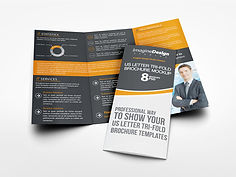Tutorial 11: Writing Your Report
Activities
A. Create a Brochure Summary of your action Research
The brochure is a high-level summary of what you have accomplished.
MSWord and many websites have free templates for designing 2-fold
brochures. Creating a brochure is a bit like creating an outline for your
report and therefore will help you organize your thoughts for more writing.

B. Assembling the Pieces into Your Action Research Report
Now is the time to work on the first draft of the whole report. If you have been following this tutorial you will have many of the pieces that you will need in draft form. Now is the time to put them together in a final document. You will decide how to share your writing. It might be on a website as an e-portfolio that you create, you may consider submitting your work to an online or print journal, creating a conference presentation, or a school exhibition of learning. Advice on how to do each of these is found in the resources. But no matter how you share your work, writing about it can be a good way first step in organizing your ideas for sharing.
OUTLINE
ACTION RESEARCH TITLE
-
Your opening description of the problem (Draft template from Tutorial 3: Activities)
-
Review of literature Draft from Tutorial 4: Activities)
-
Description of your setting and circumstances (Draft from Tutorial 4: Activities)
-
-
Your description of action research and why you are taking this approach (Draft from tutorial 2: Activities
-
Your overall research question (Draft from Tutorial 3: Activities)
-
Your logic model or force field analysis (Draft from Tutorial 5: Activities)
-
Your ethical planning for your resource. (Draft from Tutorial 5: Activities)
-
-
Cycle Reports (Tutorials 6-10)
-
Cycle One: Title
-
Discussion of the problem and your cycle question (Draft from Tutorial 6: Activities)
-
Description of the data you collected (Draft from Tutorial 7: Activities)
-
Your Analysis of the data to provide evidence (Draft from Tutorial 8: Activities)
-
Reflection on the cycle 1 leading to cycle 2 ideas (Draft from Tutorial 9)
-
-
Cycle two: Title (Tutorial 10)
-
Discussion of the problem and your cycle question (Draft from Tutorial 6: Activities)
-
Description of the data you collected (Draft from Tutorial 7: Activities)
-
Your Analysis of the data to provide evidence (Draft from Tutorial 8: Activities)
-
Reflection on the cycle 1 leading to cycle 2 ideas (Draft from Tutorial 9)
-
-
Cycle three: Title (Tutorial 10)
-
Discussion of the problem and your cycle question (Draft from Tutorial 6: Activities)
-
Description of the data you collected (Draft from Tutorial 7: Activities)
-
Your Analysis of the data to provide evidence (Draft from Tutorial 8: Activities)
-
Reflection on the cycle 1 leading to cycle 2 ideas (Draft from Tutorial 9)
-
-
-
Final Reflection overall cycle (Tutorial 9)
-
References
You might want to consult the resources for a sample rubric which might help you in writing your report.


C. Telling your Action Research Story
There are many different audiences for sharing Action Research results and for some audiences, a powerful story will be more effective than a formal research paper. If you are presenting at a conference, you may want to share the story of your journey of learning. Here your research blog will be invaluable. Reread it looking for themes and ideas that will help you organize your story. What advice do you have for other action researchers? What can they learn from your progress and outcomes? What surprised you? I can't tell you the number of students that I have taught that feel in love with reading about learning. They were captured with the mystery of what is involved in learning. And they shared that mystery with their students. Their students also fell in love with learning. Reading these blog entries and action research reflections were so insightful and wonderfully rich.
Here is a short story from a powerful action researcher who is doing ongoing action research in her classroom ...Katherine Korte
What story do you want to tell? If you had ten minutes to share the most important thing about action research, what would you say? What would you center on? What are the insights you want to share with others? Feel free to share your doubts, and concerns as well as your insights and successes, as these can be so valuable in pushing the thinking of others.
Write a reflective essay on action research and share it with an action research community and or your professional community. You could post it on a number of places including:
-
Send me your stories (mmriel@gmail.com) and I will build them into the tutorials.
-
Post on the Action Research Network of the Americas - Knowledge Mobilization -storytelling (send essays to Joe Shosh shoshj@moravian.edu
-
Post on American Educational Research Association Action Research SIG- messages from members (if you are not a member, ask me to post for you).
-
Share with the Living Theory Discussion list -- you will need to join-- Practitioner-Researcher <PRACTITIONER-RESEARCHER@jiscmail.ac.uk> Join here
We want to hear your story!


